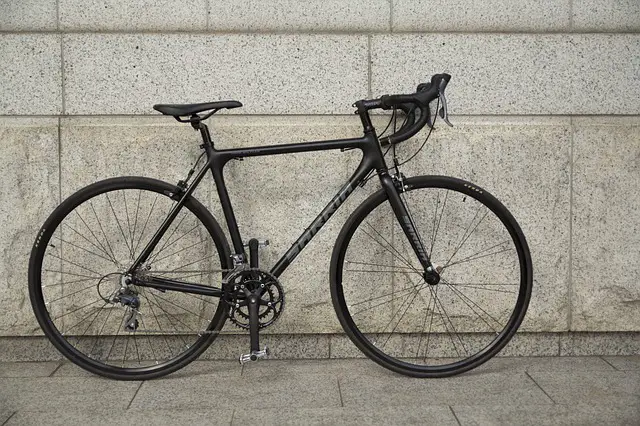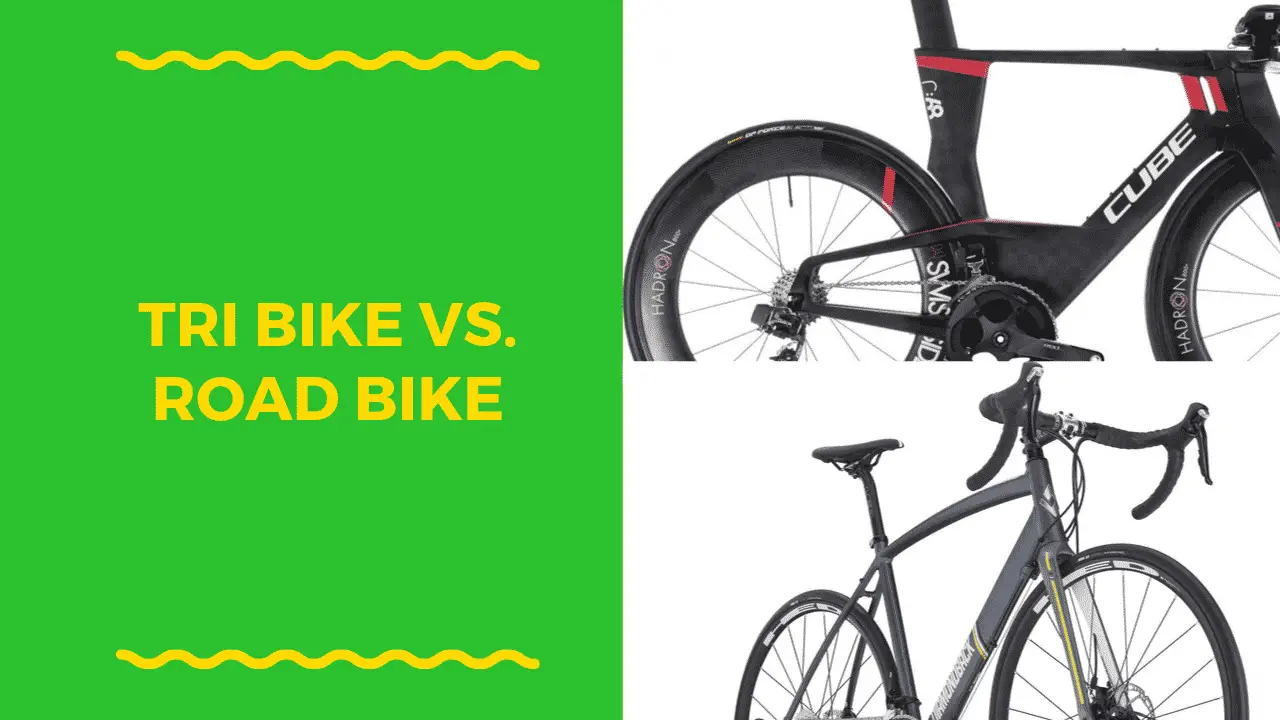While both road bikes and tri bikes are both used in a road cycling competition, the specialized triathlon bikes will give you an edge in shorter distances.
Road bikes are designed with comfort from the ground up and are ideal for longer distances. They're also lighter, making them suitably adapted for hill climbing.
Triathlon bikes, on the other hand, are designed with the racers in mind; they sport a more aggressive geometry and will keep your riding position more aerodynamic.
Now, if you’ve been wondering whether to choose between a road bike or a tri bike, journey with us as we highlight the major differences between these two bike models.
Contents
Road Bike

Road bikes are ideal for both the smooth and rough pavements and are comfortable over long distances.
Sporting more traditional bike geometry, a road bike will place you in a better position for climbing, turning, sprinting and riding in a peloton.
The road bikes are highly versatile and meant to be more dynamic, maneuverable, and lightweight.
The slacker seat tube angle on the road bikes makes these bikes better suited for better power production by allowing you to utilize the powerful quad muscles.
Featuring drop bars as opposed to the aero bar, the road bike allows the use of multiple hand positions during cycling. The drop bars offer a relaxed hand position, making the road bike more comfortable and easier to control over long distances and in varying terrains.
Triathlon Bikes

Triathlon bikes, on the other hand, are designed for use in short distances.
In most cases, the tri bikes are associated with a cycling portion of a triathlon.
Because cycling endurance is a non-issue, tri bikes are designed to offer a more aggressive riding position, thanks to the elbow-rest style aero handlebars.
The bullhorn-style bars on the tri bikes will allow you to rest your elbows on the handlebar and lower your head and body into an aerodynamic tuck.
Generally, the geometry of tri bikes bodes well with flat surfaces. Additionally, it facilitates an easy transition from cycling to running better than road bikes.
Similarities Between a Road and a Triathlon Bicycle
A common function between these two bike models is both of them can be used for a triathlon.
The common ground on these bikes arises because of the versatility of the road bikes. Beyond road cycling, road bikes can similarly be used for a triathlon.
Differences Between Road Bikes and Tri Bikes
Feature | Tri Bike | Road Bike |
Speed | Faster | Slower |
Weight | Heavy | Lighter |
Seat tube angle | 72 degrees | 78+ degrees |
Versatility | Less versatile (difficult to control during winter) | More versatile |
Price | Expensive | Budget-friendly |
Comfort | Less-comfortable | Comfortable |
Purpose | Ideal for short distances | Ideal for long distances |
The very basic difference between a triathlon and a road bike is the geometry of the frame, more specifically, the seat tube angle.
Weight
Sure, you’ve across triathletes lifting and running with their bikes over their head, but don’t get fooled into thinking the bikes are lightweight.
In reality, tri bikes are a lot heavier than road bikes, and it takes a seasoned rider to handle a triathlon bike.
The lightness of the road bikes makes them better suited for handling the steep climbs or anything with an average gradient of over 6%.
On the other hand, the tri bikes are ideal for the relatively flat surfaces.
Seat Position
The geometry of the frame, especially in relation to the seat tube angle, forms a stark basis between road and tri bike.
On a tri bike, the seat tube is steeper. Generally, tri bikes have anywhere from 76 to 78+ degree seat tube angle.
The steeper seat tube angle places you further from the "bike," allowing you to achieve an aerodynamic stance easily.
On a regular road bike, the seat tube angle is slacker, and here, you’ll get 72-degree seat tube angle.
On a tri-bike, for instance, the hips are “pushed” forward, and this gives you less rider tension and less engagement on the quadriceps and hamstrings.
Muscle Used
Road bikes incline you into a position where you strain your leg muscles such as quads and hamstrings. While this is great when you’re doing cycling alone, it’s not suitable where you’ll need to adjust your legs for running.
And this is where tri bikes come into play.
The inherent forward posture of the triathlon bikes will put you in a more aerodynamic position, and this result in less usage of the quad muscles. And this will help in saving them for the run after you jump off your bike, further underlining the suitability of a tri bike for a triathlon.
Frame Angles
Like the seat angles, a road bike has slacker frame angles than those of a tri bike.
The slacker frame angle on the road bike will give you a more upright posture until you bend the drop bars. Still, you won't achieve the bending posture of a triathlon bike.
A triathlon bike offers a frame that is streamlined into an aerodynamic shape. Here, the frames are set at steeper angles than those of a road bike, and this allows cyclists to reduce the impact on what would normally be stretched-out quadriceps.
Frame Tube
Road bikes are built for riding comfort over long distances.
Road bikes frames, for instance, are constructed from cushioning and vibration reduction material for comfort. The top tubes are typically constructed from thicker sides than the top and bottoms. This helps to dampen vibrations, while at the same time retaining stiffness for proficient energy transfer.
Tri bikes, on the other hand, provide a more streamlined frame coupled with larger flat/oval tubes. The design of the frame reduces the frontal area and helps to cut the air.
Aerodynamics/Speed-Factor
A triathlon bike is a clear winner here.
Triathlon bikes have been carefully engineered to ensure that there’s a lot of rolling resistance on the ground, and the drag is kept at minimal.
Greater aerodynamics comes with speed, and you can expect the triathlon to perform better than the road bikes.
But don’t put off the road bikes yet.
See, the ultimate performance will also depend on your effort. We’ve seen some of the seasoned cyclist riding a road bike at the same speed as many top amateur time trialists.
So, there's a lot to be said for pushing hard and buying speed later.
Handling
Road bikes come with drop handlebars.
These handlebars will allow you to place your hands within a comfortable reach of the control buttons and allow you to have optimal control of your bike. Also, the drop handlebar will enhance steering and braking power.
This is contrary to the aero handlebars on the triathlon bikes. While the aero bikes will offer a more aerodynamic shifting, they make braking and controlling the bike less comfortable. This is because aero bars require a good dose of balance, and ability to maneuver your hands from the bars to the brakes.
It’s not a surprise that group rides often don’t allow triathlon bikes due to the lack of handling.
Conclusion: Which is Better?
There’s no straight answer to this.
The choice of either a road or tri bike depends on your cycling needs.
However, if you're just starting, I would recommend a road bike as opposed to a tri bike.
I would choose comfort over everything else, and so do many.
And unless you’re a professional triathlete, a road bike has plenty of overlapping benefits and uses to a triathlon bike.
Nonetheless, whichever model you choose, ensure it`s correctly positioned and fitting.


I had a cycling accident with my road bike where the frame unfortunately had a clean break 🙁
So I need to replace the frame, however can this be replaced by a TT bike frame and usually the same components?
Why/how are tri bikes heavier?
This is because the main focus is making a time trial bike more aerodynamic rather than lightweight. TT frames tend to be heavier because of bigger ‘aerofoils’ and bigger frames.